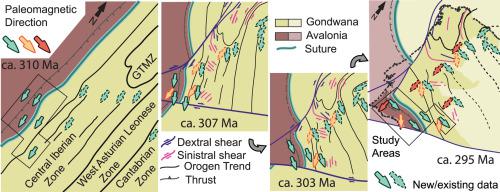Geoscience Frontiers ( IF 8.9 ) Pub Date : 2020-08-15 , DOI: 10.1016/j.gsf.2020.07.013 Bruno Daniel Leite Mendes , Daniel Pastor-Galán , Mark J. Dekkers , Wout Krijgsman

|
The amalgamation of Pangea formed the contorted Variscan-Alleghanian orogen, suturing Gondwana and Laurussia during the Carboniferous. From all swirls of this orogen, a double curve in Iberia stands out, the coupled Cantabrian Orocline and Central Iberian curve. The Cantabrian Orocline formed at ca. 315–290 Ma subsequent to the Variscan orogeny. The formation mechanism of the Cantabrian Orocline is disputed, the most commonly proposed mechanisms include either (1) that south-westernmost Iberia would be an Avalonian (Laurussian) indenter or (2) that the stress field changed, buckling the orogen. In contrast, the geometry and kinematics of the Central Iberian curve are largely unknown. Whereas some authors defend both curvatures are genetically linked, others support they are distinct and formed at different times. Such uncertainty adds an extra layer of complexity to our understanding of the final stages of Pangea’s amalgamation. To solve these issues, we study the late Carboniferous– early Permian vertical-axis rotations of SW Iberia with paleomagnetism. Our results show up to 70° counterclockwise vertical-axis rotations during late Carboniferous times, concurring with the anticipated kinematics if SW Iberia was part of the southern limb of the Cantabrian Orocline. Our results do not allow the necessary penecontemporaneous clockwise rotations in Central Iberia to support a concomitant formation of both Cantabrian and Central Iberian curvature. The coherent rotation of both Gondwanan and Avalonian pieces of SW Iberia discards the Laurussian indenter hypothesis as a formation mechanism of the Cantabrian Orocline and confirms the Greater Cantabrian Orocline hypothesis. The Greater Cantabrian Orocline likely formed as a consequence of a change in the stress field during the late Carboniferous and extended beyond the Rheic Ocean suture affecting the margins of both Laurussia and Gondwana.
中文翻译:

Avalonia,弯腰!–来自伊比利亚西南部的古磁性证实了大坎塔布连Orocline
Pangea的合并形成了扭曲的Variscan-Alleghanian造山带,在石炭纪时期缝合了Gondwana和Laurussia。从该造山带的所有漩涡中,伊比利亚的双曲线引人注目,即坎塔布连Orocline和伊比利亚中部曲线耦合。坎塔布连Orocline形成于约。Variscan造山带之后的315-290 Ma。Cantabrian Orocline的形成机制是有争议的,最普遍提出的机制包括(1)最西南的伊比利亚是Avalonian(Laurussian)压头,或者(2)应力场发生了变化,使造山带屈曲。相反,伊比利亚中部曲线的几何形状和运动学在很大程度上是未知的。尽管有些作者认为两个曲率是遗传相关的,但另一些人则认为它们是不同的并且在不同的时间形成。这种不确定性为我们对Pangea合并的最后阶段的理解增加了额外的复杂性。为了解决这些问题,我们研究了古伊贝里亚岩层与古磁铁矿晚期石炭纪至二叠纪早期的垂直轴旋转。我们的结果显示,石炭纪晚期,垂直轴最多可逆时针旋转70°,这与SW Iberia是Cantabrian Orocline南部肢体的一部分的预期运动学一致。我们的结果不允许在中伊比利亚中部进行必要的准时针顺时针旋转以支持坎塔布连和伊比利亚中部曲率的同时形成。SW Iberia的Gondwanan和Avalonian碎片的连贯旋转抛弃了Laurussian压头假说作为Cantabrian Orocline的形成机制,并证实了Cantabrian Orocline大假说。较大的Cantabrian Orocline可能是石炭纪晚期应力场变化的结果,并延伸到影响莱茵河和冈瓦纳边缘的流变缝合线之外。



























 京公网安备 11010802027423号
京公网安备 11010802027423号